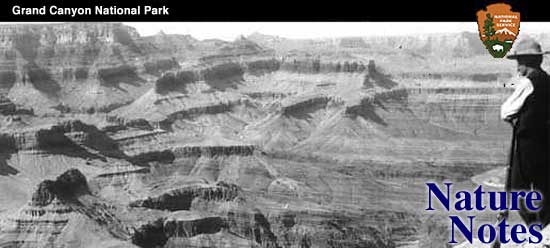

|
By Ranger Naturalist A. R. Croft ON FRIDAY, July 8th, nature provided an excellent demonstration of the effectiveness of a heavy rain in eroding the walls of Grand Canyon. At that time about twenty five people were in the vicinity of Yavapai Observation Station when a storm broke. All the adjectives usually applied to a raging rain could have been used in that case without danger of exaggeration. The rain cane down "in sheets - in buckets full". Beyond the large west window at the Observation Station this somewhat rare demonstration of erosion was being staged by the forces of nature - the same forces that have been operative in eroding the canyon walls for vast numbers of years. The crowd watched, first in silence and then with mild exclamations of astonishment. The canyon side as far as visible was literally a sheet of water. The water was thick with sand and mud, and rocks of considerable size were being moved downward by its force. The entire surface seemed to be moving toward the canyon bottom. The storm raged for twenty minutes and when it lifted, every side canyon and depression contained a stream of liquid mud. Through half a dozen binoculars the crowd watched. Some streams of very large size could be seen in washes that are usually dry. The reflection of the sun's rays on the water revealed hundreds of silvery streamlets making their way to the river laden with upland sand. A few thousand more tons of sediment had been started towards the flood plain of the Colorado and a small group of tourists had received an excellent lesson in erosion. | ||||||
| <<< Previous | > Cover < | Next >>> |
vol7-5e.htm
14-Oct-2011